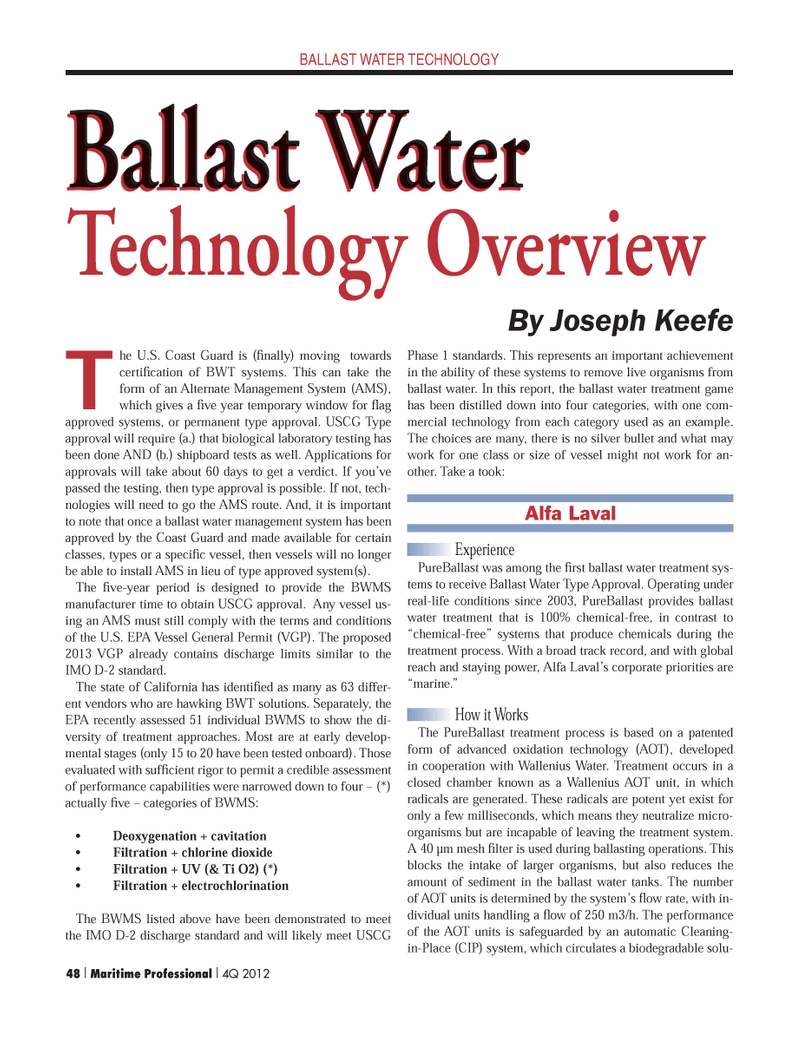
Page 48: of Maritime Logistics Professional Magazine (Q4 2012)
The Environment: Stewardship & Compliance
Read this page in Pdf, Flash or Html5 edition of Q4 2012 Maritime Logistics Professional Magazine
Ballast Water BALLAST WATER TECHNOLOGY The U.S. Coast Guard is (Þ nally) moving towards certiÞ cation of BWT systems. This can take the form of an Alternate Management System (AMS), which gives a Þ ve year temporary window for ß ag approved systems, or permanent type approval. USCG Type approval will require (a.) that biological laboratory testing has been done AND (b.) shipboard tests as well. Applications for approvals will take about 60 days to get a verdict. If youÕve passed the testing, then type approval is possible. If not, tech- nologies will need to go the AMS route. And, it is important to note that once a ballast water management system has been approved by the Coast Guard and made available for certain classes, types or a speciÞ c vessel, then vessels will no longer be able to install AMS in lieu of type approved system(s). The Þ ve-year period is designed to provide the BWMS manufacturer time to obtain USCG approval. Any vessel us- ing an AMS must still comply with the terms and conditions of the U.S. EPA Vessel General Permit (VGP). The proposed 2013 VGP already contains discharge limits similar to the IMO D-2 standard.The state of California has identiÞ ed as many as 63 differ- ent vendors who are hawking BWT solutions. Separately, the EPA recently assessed 51 individual BWMS to show the di- versity of treatment approaches. Most are at early develop- mental stages (only 15 to 20 have been tested onboard). Those evaluated with sufÞ cient rigor to permit a credible assessment of performance capabilities were narrowed down to four Ð (*) actually Þ ve Ð categories of BWMS: Deoxygenation + cavitation Filtration + chlorine dioxide Filtration + UV (& Ti O2) (*) Filtration + electrochlorination The BWMS listed above have been demonstrated to meet the IMO D-2 discharge standard and will likely meet USCG Phase 1 standards. This represents an important achievement in the ability of these systems to remove live organisms from ballast water. In this report, the ballast water treatment game has been distilled down into four categories, with one com- mercial technology from each category used as an example. The choices are many, there is no silver bullet and what may work for one class or size of vessel might not work for an- other. Take a took: ExperiencePureBallast was among the Þ rst ballast water treatment sys- tems to receive Ballast Water Type Approval. Operating under real-life conditions since 2003, PureBallast provides ballast water treatment that is 100% chemical-free, in contrast to Òchemical-freeÓ systems that produce chemicals during the treatment process. With a broad track record, and with global reach and staying power, Alfa LavalÕs corporate priorities are Òmarine.Ó How it Works The PureBallast treatment process is based on a patented form of advanced oxidation technology (AOT), developed in cooperation with Wallenius Water. Treatment occurs in a closed chamber known as a Wallenius AOT unit, in which radicals are generated. These radicals are potent yet exist for only a few milliseconds, which means they neutralize micro- organisms but are incapable of leaving the treatment system. A 40 µm mesh Þ lter is used during ballasting operations. This blocks the intake of larger organisms, but also reduces the amount of sediment in the ballast water tanks. The number of AOT units is determined by the systemÕs ß ow rate, with in- dividual units handling a ß ow of 250 m3/h. The performance of the AOT units is safeguarded by an automatic Cleaning- in-Place (CIP) system, which circulates a biodegradable solu- Ballast Water Technology Overview Alfa LavalBy Joseph Keefe 48 I Maritime Professional I 4Q 2012MP #4 34-49.indd 48MP #4 34-49.indd 4811/12/2012 9:50:00 AM11/12/2012 9:50:00 AM

 47
47

 49
49
